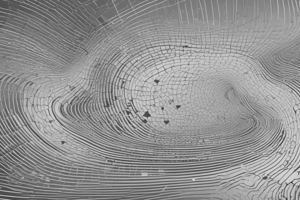Podcast
Questions and Answers
What is the result of adding two vectors A = 3i + 4j and B = 2i - 5j?
What is the result of adding two vectors A = 3i + 4j and B = 2i - 5j?
- i + 9j
- 5i + j
- i - 9j
- 5i - j (correct)
If vector A = 2i + 3j and vector B = 4i - 2j, what is the result of A - B?
If vector A = 2i + 3j and vector B = 4i - 2j, what is the result of A - B?
- 2i + 5j
- -2i - 5j
- 2i - 5j
- -2i + 5j (correct)
What is the magnitude of the vector A = 3i + 4j?
What is the magnitude of the vector A = 3i + 4j?
- 5 (correct)
- 7
- 3
- 1
If two vectors have the same direction, what can be said about their addition?
If two vectors have the same direction, what can be said about their addition?
What is true about the subtraction of two vectors with the same direction?
What is true about the subtraction of two vectors with the same direction?
Flashcards are hidden until you start studying
Study Notes
Vector Addition and Subtraction
- The result of adding two vectors A = 3i + 4j and B = 2i - 5j is (3i + 4j) + (2i - 5j) = (3 + 2)i + (4 - 5)j = 5i - j.
Vector Subtraction
- The result of subtracting vector B = 4i - 2j from vector A = 2i + 3j is (2i + 3j) - (4i - 2j) = (2 - 4)i + (3 + 2)j = -2i + 5j.
Vector Magnitude
- The magnitude of the vector A = 3i + 4j is √(3² + 4²) = √(9 + 16) = √25.
Vector Directions
- If two vectors have the same direction, their addition results in a vector with the same direction, but with a magnitude equal to the sum of the magnitudes of the individual vectors.
- If two vectors have the same direction, their subtraction results in a vector with the same direction, but with a magnitude equal to the difference of the magnitudes of the individual vectors.
Studying That Suits You
Use AI to generate personalized quizzes and flashcards to suit your learning preferences.




